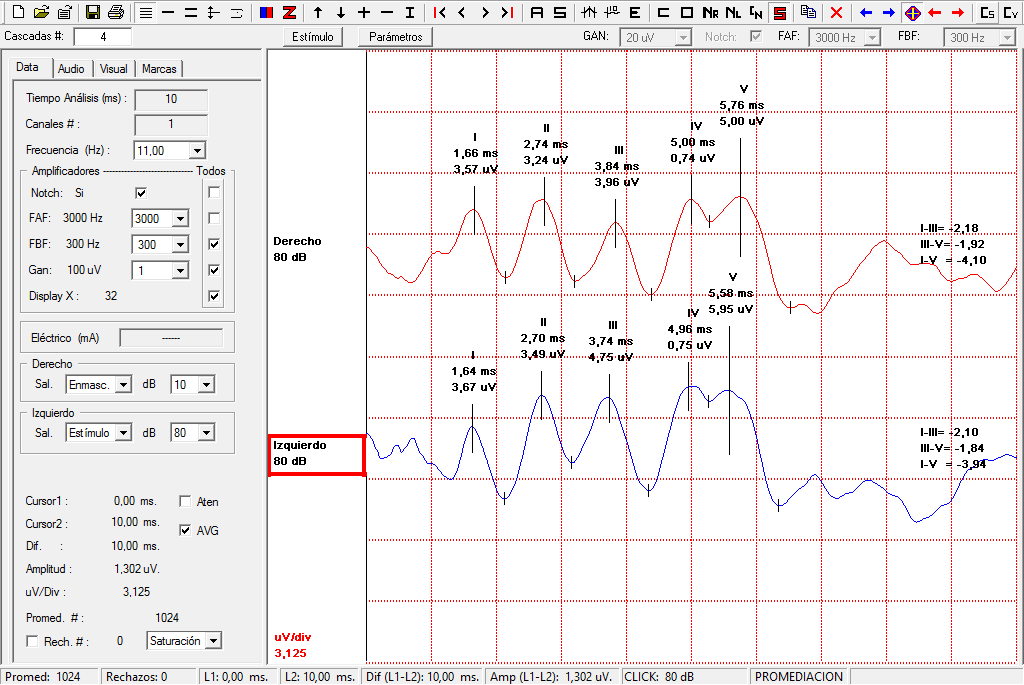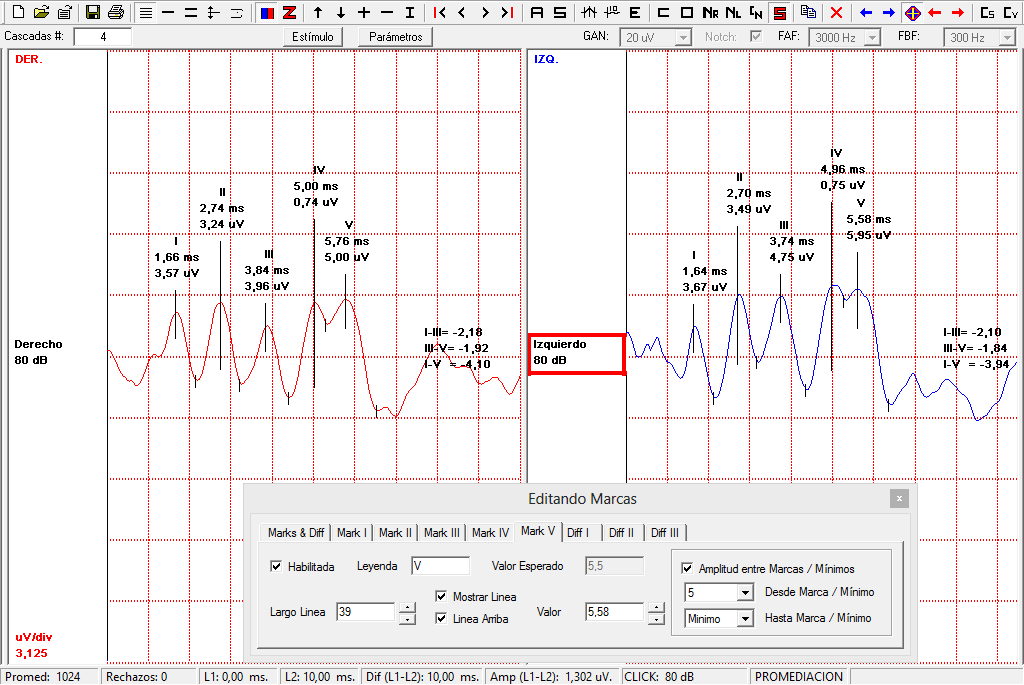Ear, Nose, and Throat Equipment in Buenos Aires City
Otorhinolaryngology and neuro-ophthalmology
At Akonic SA we have otorhinolaryngological equipment such as the BIO-PC (desktop and notebook). Below, you will find some information of interest about this system.
technical specifications
Security:
- Electrical safety according to EN60601-1 standards.
Required operating system:
- Windows XP/NT/2000/Vista/Seven/Windows 8.
Stimulators:
- Audio stimulator: click/masking - tone/masking.Checkerboard stimulator (pattern reversal).Electrical stimulator.SLD photostimulator.SLD-W photostimulator.
Self-diagnostics:
- Calibration generator. Online electrode impedance measurement.
System caracteristics
The system has:
Line input: 90/240 VAC @ 50/60 Hz.
Fuses: 1A - type T (slow).
Temperature: 5 - 30 °C.
Relative humidity: < 50% non-condensing.
Self-diagnostics: calibration generator. Electrode impedance measurement.
A/D resolution: 16 bits.
Number of channels: 32 channels system reference 7 ground inputs.
EEG channels:
Input impedance: > 20 MOhm.
Hardware low frequency filter: 0.5 Hz.
Hardware high frequency filter: 100 Hz.
Hardware Notch Filter: 50/60 Hz.
Digital Low/High/Notch Filter: User selectable.
Sensitivity: 1 to 128 µV/mm. User selectable.
CMRR: > 100 dB a 50/60 Hz.
Canales EMG / EP:
Input impedance: > 20 MOhm.
Low/High/Notch Filters: User selectable.
Hardware low frequency filter (Hz): 0.15 - 0.5 - 1.5 - 5 - 10 - 30 - 100 - 300.
Hardware high frequency filter (Hz): 10000 - 5000 - 3000 - 2000 - 1000 - 300 - 100 - 30.
Hardware Notch Filter: 50/60 Hz.
Sensitivity (µV): User selectable.
CMRR: > 100 dB a 50/60 Hz.
EKG channels:
Input impedance: > 20 MOhm.
Hardware low frequency filter: 0.15 Hz.
Hardware high frequency filter: 25 Hz.
Hardware Notch Filter: 50/60 Hz.
Sensitivity: 1/128 µV/mm. User selectable.
CMRR: > 100 dB a 50/60 Hz.
FA, Belt1 and Belt2 channels:
Input impedance: > 20 MOhm.
Hardware low frequency filter: 0.07 Hz.
Hardware high frequency filter: 100 Hz.
Hardware Notch Filter: 50/60 Hz.
Low/High/Notch Digital Filters: User selectable.
Sensitivity (max): 50 µV/mm. User selectable.
CMRR: > 100 dB a 50/60 Hz.
Canal MIC:
Input impedance: > 20 MOhm.
Hardware low frequency filter: 15 Hz.
Hardware high frequency filter: 300 Hz.
Hardware Notch Filter: 50/60 Hz.
Sensitivity: 1/128 µV/mm. User selectable.
CMRR: > 100 dB a 50/60 Hz.
External channels (Ext1 - Ext2):
Use: oximetry / pH / CPAP pressure / other DC signals.
Input impedance: 220 KOhm.
Hardware low frequency filter: DC.
Hardware high frequency filter: 70 Hz.
Low/High/Notch Digital Filters: User selectable.
Maximum input voltage: ±4 volts.
Input Voltage Range: User Selectable.
In addition, you can find information about the software that this system works with:
Evoked Potentials Software V11
PE V11 software is a Windows based software for data acquisition, analysis and reporting. Their characteristics are:
Required operating system:
- Windows XP/Seven/Windows 8.
Required hardware:
- BIO-PC™ system.
Software Features:
- Online impedance measurement.Digital filters.Direct and average presentation.Unlimited number of traces on screen.Automatic marks with manual correction.FFT (Fast Fourier Transformer) analysis.Quick menus and easy review of the study.Cursors for latency and amplitude measurements. .Frequency of stimulation by software (plateau, rise-decay, tones and polarity of the stimulus).Selection of the color of the trace.High quality printing with all types of printer.Online help.Graphic screen capture as .bmp files.User's Manual user submitted in .pdf format.
Full PE Tests:
- Short, medium and long latency auditory PE. Trunk PE (BERA). Cortical auditory PE (CERA). Cognitive auditory PE. Motor PE. Cognitive PE. Electrocochleography. Lower and upper limb somatosensory PE. Electroretinography. Flash visual PE .PE visuals by checkerboard (pattern reversal).PE visuals with glasses (Goggles).PE cognitive visuals (flash, pattern, goggles, bmp).
Technical specifications:
- Number of channels: 2, 4 and 8 channels. High frequency filter (Hz): 10000 - 5000 - 3000 - 2000 - 1000 - 500 - 100 - 30. Low frequency filter (Hz): 0.15 - 0.5 - 1.5 - 5 - 10 - 30 - 100 - 300. Notch filter: 50/60 Hz. Sensitivity: 1 - 2 - 5 - 10 - 20 - 50 - 100 µV. Input impedance: > 20 MOhm. CMRR: > 110 dB at 50/60 Hz. Noise level: 0.7 µV.
Stimulators:
- Click/masking.Tones and P-300 (250-500-1000-1500-2000-3000-4000-6000-8000 Hz tones).Binaural, insert earphone.Checkerboard (pattern reversal) .Flash: Super Light Diodes (leds).Goggles.BMP images.Electrical stimulator (CC).


Available applications:
- Digital EEG.Digital polysomnography with analysis.Topographic brain mapping (qEEG).FFT analysis.Digital video monitoring of EEG/PSG.Event Related Potentials.Electromyography.Steady state.EEG ambulatory Holter.
Electronystagmography, electrooculography and caloric tests
The features of the Nystagmography (Nis V10) software are:
- Software under Windows.
Required operating system:
- Windows XP/Seven/Windows 8.
Required hardware:
- BIO-PC™ system.
Software Features:
Possibility of carrying out three types of studies:
- Head position.Oculography (256 led cross):Sinusoidal.Triangular.Right optokinetics.Left optokinetics.Saccade.Random saccade by time.Random saccade by position.Random saccade by time and position.Caloric tests.
You can download the brochure by clicking here.

Otoacoustic emissions
Akonic SA's otoacoustic emission system is a small, lightweight portable equipment that easily connects to your notebook or desktop computer via USB port.
Features:
- Lightweight transducer, individually calibrated for accuracy Significantly reduced noise, with optimal signal-to-noise ratio Easy review of studies Word-processed reports Multi-option graphical reports, on-screen and for print Generation of .bmp graphs, partial or full screen.Indicator of number of acquisitions.Indicator of number of rejections.
Security:
- Electrical safety according to EN60601-1 standards.
Required operating system:
- Windows XP/Seven/Windows 8.
System caracteristics:
- Line input: 220 VAC @ 50/60 Hz.Fuses: 1A - type T (slow).Temperature: 5 - 30 °C.Relative humidity: < 50% non-condensing.Self-diagnostics: tip verification test.Resolution A/ D: 16 bits. Microphone noise: -20 dB.
Evoked transient acoustic otoemissions (TEOAE):
- Analysis time: 25 ms. Power ranges: µPa / mPa. Input sensitivity: 20 - 70 dB SPL. Number of measurements: 10 per side. Number of buffers: A and B. Spectral power graph. Power. Stimulus Duration: 50 - 100 - 200 - 300 - 400 µsec (linear). Stimulation Level: 0 - 70 dB SPL. Output Protection: Limited to 85 dB SPL.

Spontaneous acoustic emissions (SOAE):
- Frequency ranges: 0-2500, 0-5000, 2500-5000, 5000-10000 Hz. Input sensitivity: 20 - 70 dB SPL. Number of measurements: 10 per side. Presentation: spectral power and/or input signal. Stimulation level: 0 - 70 dB SPL.
Distortional Product Otoacoustic Emissions (DPOAE):
- Presentation: narrow / wide Frequency ranges: 0-2500, 0-5000, 2500-5000, 5000-10000 Hz Input sensitivity: 20 - 70 dB SPL Number of measurements: 10 per side Stimulus: 2 independent channels of sinusoidal stimulation. Geometric center: 500 - 750 - 1000 - 1500 - 2000 - 3000 - 4000 - 6000 - 8000 Hz. Stimulation level: 0 - 70 dB SPL.
Screening of acoustic otoemissions:
- Indication of pass / no pass. You can download the brochure by clicking here.




